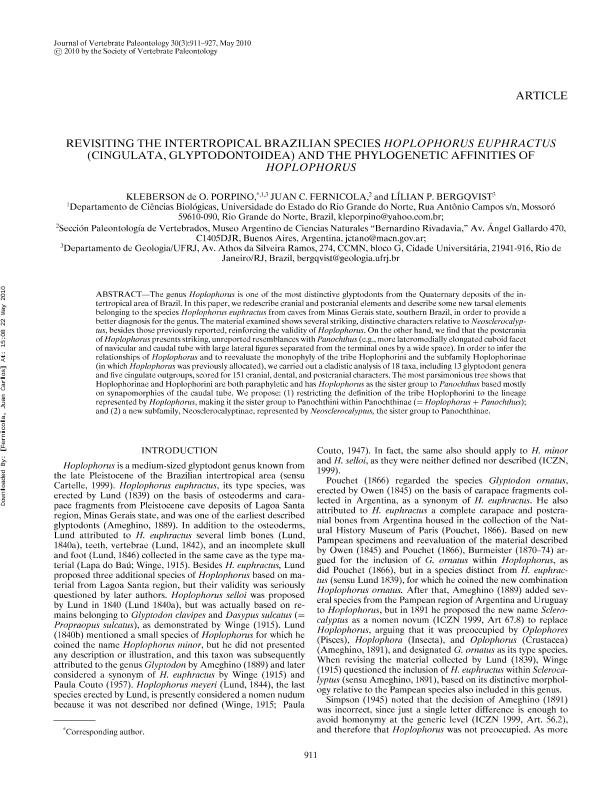Mostrar el registro sencillo del ítem
dc.contributor.author
Porpino, Kleberson de O.

dc.contributor.author
Fernicola, Juan Carlos

dc.contributor.author
Bergqvist, Lílian P.
dc.date.available
2019-01-30T21:18:11Z
dc.date.issued
2010-05
dc.identifier.citation
Porpino, Kleberson de O.; Fernicola, Juan Carlos; Bergqvist, Lílian P.; Revisiting the Intertropical Brazilian Species Hoplophorus euphractus (Cingulata, Glyptodontoidea) and the Phylogenetic Affinities of Hoplophorus; Society of Vertebrate Paleontology; Journal of Vertebrate Paleontology; 30; 3; 5-2010; 911-927
dc.identifier.issn
0272-4634
dc.identifier.uri
http://hdl.handle.net/11336/69074
dc.description.abstract
The genus Hoplophorus is one of the most distinctive glyptodonts from the Quaternary deposits of the intertropical area of Brazil. In this paper, we redescribe cranial and postcranial elements and describe some new tarsal elements belonging to the species Hoplophorus euphractus from caves from Minas Gerais state, southern Brazil, in order to provide a better diagnosis for the genus. The material examined shows several striking, distinctive characters relative to Neosclerocalyptus, besides those previously reported, reinforcing the validity of Hoplophorus. On the other hand, we find that the postcrania of Hoplophorus presents striking, unreported resemblances with Panochthus (e.g., more lateromedially elongated cuboid facet of navicular and caudal tube with large lateral figures separated from the terminal ones by a wide space). In order to infer the relationships of Hoplophorus and to reevaluate the monophyly of the tribe Hoplophorini and the subfamily Hoplophorinae (in which Hoplophorus was previously allocated), we carried out a cladistic analysis of 18 taxa, including 13 glyptodont genera and five cingulate outgroups, scored for 151 cranial, dental, and postcranial characters. The most parsimonious tree shows that Hoplophorinae and Hoplophorini are both paraphyletic and has Hoplophorus as the sister group to Panochthus based mostly on synapomorphies of the caudal tube. We propose: (1) restricting the definition of the tribe Hoplophorini to the lineage represented by Hoplophorus, making it the sister group to Panochthini within Panochthinae (= Hoplophorus + Panochthus); and (2) a new subfamily, Neosclerocalyptinae, represented by Neosclerocalyptus, the sister group to Panochthinae.
dc.format
application/pdf
dc.language.iso
eng
dc.publisher
Society of Vertebrate Paleontology

dc.rights
info:eu-repo/semantics/openAccess
dc.rights.uri
https://creativecommons.org/licenses/by-nc-sa/2.5/ar/
dc.subject
Hoplophorus Eupharctus
dc.subject
Glyptodontia
dc.subject
Phylogeny
dc.subject
Brasil
dc.subject.classification
Meteorología y Ciencias Atmosféricas

dc.subject.classification
Ciencias de la Tierra y relacionadas con el Medio Ambiente

dc.subject.classification
CIENCIAS NATURALES Y EXACTAS

dc.title
Revisiting the Intertropical Brazilian Species Hoplophorus euphractus (Cingulata, Glyptodontoidea) and the Phylogenetic Affinities of Hoplophorus
dc.type
info:eu-repo/semantics/article
dc.type
info:ar-repo/semantics/artículo
dc.type
info:eu-repo/semantics/publishedVersion
dc.date.updated
2019-01-30T13:56:15Z
dc.journal.volume
30
dc.journal.number
3
dc.journal.pagination
911-927
dc.journal.pais
Estados Unidos

dc.journal.ciudad
Lawrence
dc.description.fil
Fil: Porpino, Kleberson de O.. Universidade Federal do Rio Grande do Norte; Brasil
dc.description.fil
Fil: Fernicola, Juan Carlos. Consejo Nacional de Investigaciones Científicas y Técnicas. Oficina de Coordinación Administrativa Parque Centenario. Museo Argentino de Ciencias Naturales “Bernardino Rivadavia”; Argentina
dc.description.fil
Fil: Bergqvist, Lílian P.. Universidade Federal do Rio de Janeiro; Brasil
dc.journal.title
Journal of Vertebrate Paleontology

dc.relation.alternativeid
info:eu-repo/semantics/altIdentifier/doi/https://doi.org/10.1080/02724631003765735
dc.relation.alternativeid
info:eu-repo/semantics/altIdentifier/url/https://bit.ly/2sZjZUg
Archivos asociados
